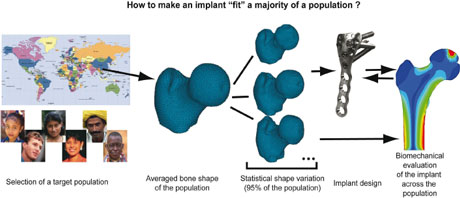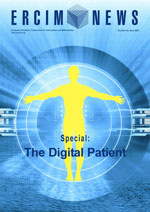by Miguel A. González Ballester, Philippe Büchler and Nils Reimers
Researchers at the MEM Research Center (Institute for Surgical Technology and Biomechanics, University of Bern), in collaboration with Stryker Osteosynthesis, are constructing advanced statistical digital models of bone shape and biomechanical properties. These models will lead to the design of a new breed of orthopaedic implants that will guarantee an optimal fit for the whole range of patients.
Current design processes for orthopaedic implants rely on very limited information about the shape of the target bone. Such information may be in the form of a small set of shape parameters (eg lengths and angles) derived from the existing literature, which fails to capture the complexity of real anatomical shapes. Alternatively, tests on cadaver bones can be performed. However, extrapolating the findings reached by such tests to the whole target population can lead to implants that may fit some patients, but not others. The importance of determining a range of implants that fit most of the population is paramount, both from a clinical and an economic perspective.
For this reason, the current project uses novel population-based design methods to develop market-specific trauma implants. Our technology allows a compact model that represents the range of shape variation encountered in a set of different 3D shapes (in this case bones) to be automatically built. Statistical analysis techniques are employed to determine the average bone shape in a given population, as well as the shape distribution around this average in the form of principal components of shape variation. From such a distribution it is possible to generate new virtual shapes, and in particular to create a set of models representing, for example, 95% of the shape variability in the population.

During this project, we have extended our ability to analyse the surface shape of anatomies to also include internal structures and bone density information. This results in a compact statistical description of the variability in bone shape and density, and the correlation between them. To this end, novel methodological contributions are being developed, tested and applied to the particular case of bone modelling. As a side product of this development, it is possible to generate realistic synthetic image data sets for further virtual testing and assessment of the anchoring performance of the developed implants.
For this project, a large database of computer tomography (CT) scans of bones from different populations is being constructed. Statistical analysis is performed and it is then possible to generate new bone instances covering a representative cross-section of the population. This includes both the bone surface, which will be used to contour an optimally fitting implant, as well as bone mineral density, to allow the best positioning for fixation to be determined.
The biomechanical behaviour of the bone/implant construct will also be taken into consideration during the design process. Advanced finite element analysis (FEA) has been coupled with the statistical models of bone shape and density previously created to evaluate implant design across a population. Initial evaluations will focus on the implant strength and primary function. Then, since it is well known that the mechanical environment around the fracture site strongly influences the healing process, mechanical parameters important for the fracture healing will be calculated. By sampling the statistical model, which contains the variation in shape and bone density across the population, and performing the FEA experiment as described above on each instance, we are able to reconstruct the statistical distribution of biomechanical properties across the population. These results will allow the selection of an implant that will create the optimal mechanical conditions for bone healing.
In short, in this project we are developing and applying technology that will lead to better implant design, in terms of both morphology and biomechanical performance. This is achieved by building digital models of human anatomy and biomechanical properties, which allow virtual implant testing to be performed across a target population.
This project is funded by the Swiss Innovation Promotion Agency (CTI/KTI) and the Swiss National Science Foundation (SNSF), through the National Center of Competence in Research on Computer-Aided and Image-Guided Medical Interventions (NCCR Co-Me).
Please contact:
Miguel A. González Ballester
MEM Research Center, University of Bern
Tel: +41-316315950
E-mail: miguel.gonzalez![]() MEMcenter.unibe.ch
MEMcenter.unibe.ch










